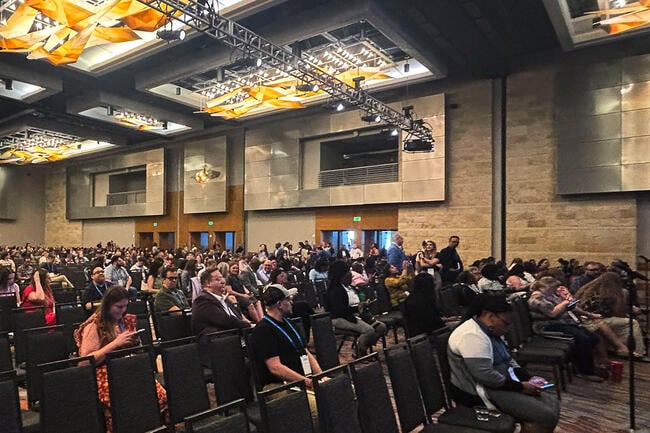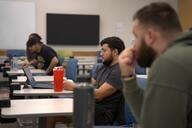You have /5 articles left.
Sign up for a free account or log in.

Attendees attend the opening keynote address at the Hyatt Regency on June 28.
Ashley Mowreader/Inside Higher Ed
DENVER—The 1,500 student affairs professionals filling the ballroom at the downtown Hyatt Regency had gathered in unity and commiseration, looking for support to tackle the mounting challenges they face: declining public confidence in higher education, financial barriers for student retention and burnout in a field that has lately withstood a barrage of attacks.
The attendees had assembled for the annual Student Success in Higher Education conference hosted by NASPA, the national association for student affairs professionals. The event, held in a different city each summer, is built around three tracks: data and assessment, supporting first-generation students, and dismantling barriers to equity.
While this year’s conference wasn’t a direct response to intensifying government attacks on diversity, equity and inclusion work in higher education, the connection was evident, as conversations among attendees and speaker comments made clear.
“I want to acknowledge where we are and what needs to be done,” said keynote speaker Tia Brown McNair, partner at the higher education consulting firm SOVA and former vice president for diversity, equity and student success at the American Association of Colleges and Universities. “This is no longer an internal battle. It is external, and we have to acknowledge that in order to do the work that is necessary.”
Compared to NASPA’s main annual conference, which boasts 6,500 attendees, SSHE is more intimate, focused on the practitioners engaging with students each day, including academic advisers, housing and residence life staff, and senior leaders with “student success” in their titles.
Over the past year, federal and state orders targeting higher education have caused a scramble in the student affairs world, where most institutional DEI offices are—or were—housed. Staff have seen colleagues laid off or “reorganized” as departments and divisions have closed, rebranded or hidden themselves in plain sight.
Part of the challenge is defining what equity work is, McNair noted in her address. “We don’t want some students to succeed and some students to fail,” she said. “We are in this business doing the work that we do, and why we’re committed to this is because we believe strongly in the success of every single student.” But the message has been lost along the way, she added.
A recently published report from NASPA, which collected data from 60 student affairs professionals in 14 states with DEI bans, found that 64 percent reported a less inclusive campus climate and 59 percent had made structural changes at their institution due to legal challenges, including renaming an office, laying off employees or reorganizing departments.
Many of these changes were made in the absence of explicit directives, focused instead on minimizing risk, said Diana Ali, director for policy, research and advocacy at NASPA, in a session regarding policy change. For most institutions, student success is always the goal, but how it’s framed and where it belongs in organizational charts is under pressure.
“The work hasn’t stopped; what we’ve seen is a shift in how it’s happening,” Ali said about colleges facing state anti-DEI laws.
“I think the challenge of fear is everywhere now,” said one staff member from California at Ali’s session. “It’s just a blatant attack on higher ed.”
“You’re on a tightrope,” another attendee from Texas added. “People are worried about everything they say.”
Attendees expressed fear of burnout as they try to juggle new challenges. “We signed up for a certain job, and the landscape has changed,” as one staff member put it. A different staff member likened the policy changes to the extinction of prehistoric creatures, saying, “We’re dinosaurs being attacked by asteroids.”
Others emphasized the importance of university leaders setting a calm and neutral tone in the face of vague legal language and a steady stream of federal orders; they applauded the presidents and deans who offered clear and actionable insight into new regulations.
The conference aims to provide promising practices, research and solutions to improve student success—which attendees seemed eager to share with one another. But some speakers said they were wary of publicly touting the interventions and initiatives they created for marginalized students, worried about making their program a target for opponents of DEI work.
A speaker addressing undocumented student supports asked attendees not to take pictures of the slides or record the session—and to give second thought to any notes they took. “Whatever you do write in your notes, consider the delicacy of this topic,” the speaker said at the start of the session, which took place behind closed doors.
The session didn’t reveal secrets of how to avoid immigration officials or even explicitly address federal and state laws regarding immigration concerns. Instead, attendees learned about the value of fellowships and private funders to ensure that first-generation students—regardless of legal standing—were able to serve as mentors to high school students interested in postsecondary education.
During her keynote, McNair shared resources published by the advocacy group Higher Ed Forward, encouraging attendees to take photos. But she noted the organization hadn’t published them widely “because we don’t want for it to get into the wrong hands.”
Even during presentations not focused on actions that could be classified as DEI, speakers expressed feelings of uncertainty. “We’re in it, we see it, we’ve got a crazy undertow, but we gotta keep going,” said an associate vice president for student success at a historically Black university.
While the conference addressed professionals’ fears, it also encouraged empathy, understanding and purpose. The fear was palpable, but it wasn’t felt in isolation. And for many, the gathering was a good reminder of why they got into student affairs work in the first place.
As one attendee said after McNair’s keynote address, “I want to thank you for igniting a flame in me that was dwindling down.”




